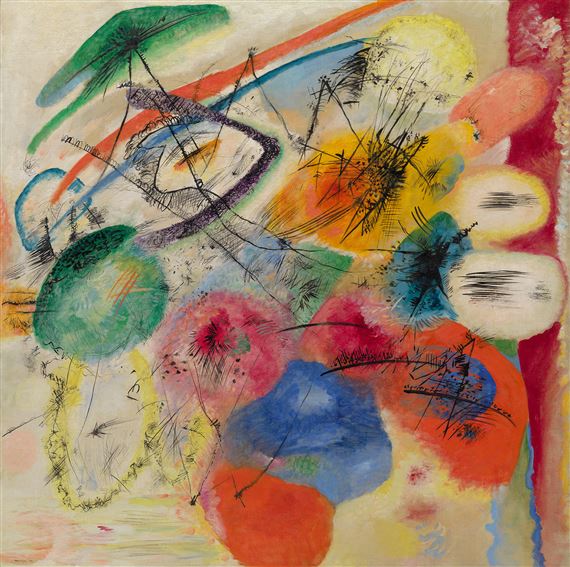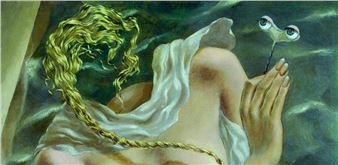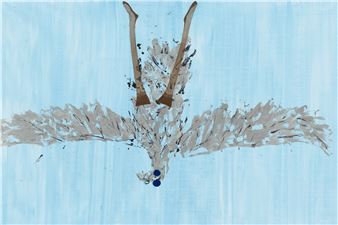Kandinsky
As a pioneer of abstraction and a renowned aesthetic theorist, Vasily Kandinsky (b. 1866, Moscow; d. 1944, Neuilly-sur-Seine, France) is among the foremost artistic innovators of the early twentieth century. In his endeavor to free painting from its ties to the natural world, Kandinsky discovered a new subject matter based solely on the artistŌĆÖs ŌĆ£inner necessityŌĆØ that would remain his lifelong concern.
In Munich in the 1900s and early 1910s, Kandinsky began exploring the expressive possibilities of color and composition, but he was abruptly forced to leave Germany with the outbreak of World War I, in 1914. The artist eventually returned to his native Moscow, and there his pictorial vocabulary started to reflect the utopian experiments of the Russian avant-garde, who emphasized geometric shapes in an effort to establish a universal aesthetic language. Kandinsky subsequently joined the faculty of the Bauhaus, a German school of art and applied design that shared his belief in artŌĆÖs ability to transform self and society. Compelled to abandon Germany again when the Bauhaus closed under Nazi pressure in 1933, he settled outside Paris, where Surrealism and the natural sciences influenced KandinskyŌĆÖs biomorphic imagery.
More so than any other artist, Kandinsky is intertwined with the history of the Solomon R. Guggenheim Foundation, established in New York in 1937. Industrialist and museum founder Solomon R. Guggenheim began collecting KandinskyŌĆÖs work in 1929 and met him at the Dessau Bauhaus the following year. This exhibition draws from the foundationŌĆÖs extensive holdings to illustrate the full arc of KandinskyŌĆÖs seminal career.

Recommended for you
As a pioneer of abstraction and a renowned aesthetic theorist, Vasily Kandinsky (b. 1866, Moscow; d. 1944, Neuilly-sur-Seine, France) is among the foremost artistic innovators of the early twentieth century. In his endeavor to free painting from its ties to the natural world, Kandinsky discovered a new subject matter based solely on the artistŌĆÖs ŌĆ£inner necessityŌĆØ that would remain his lifelong concern.
In Munich in the 1900s and early 1910s, Kandinsky began exploring the expressive possibilities of color and composition, but he was abruptly forced to leave Germany with the outbreak of World War I, in 1914. The artist eventually returned to his native Moscow, and there his pictorial vocabulary started to reflect the utopian experiments of the Russian avant-garde, who emphasized geometric shapes in an effort to establish a universal aesthetic language. Kandinsky subsequently joined the faculty of the Bauhaus, a German school of art and applied design that shared his belief in artŌĆÖs ability to transform self and society. Compelled to abandon Germany again when the Bauhaus closed under Nazi pressure in 1933, he settled outside Paris, where Surrealism and the natural sciences influenced KandinskyŌĆÖs biomorphic imagery.
More so than any other artist, Kandinsky is intertwined with the history of the Solomon R. Guggenheim Foundation, established in New York in 1937. Industrialist and museum founder Solomon R. Guggenheim began collecting KandinskyŌĆÖs work in 1929 and met him at the Dessau Bauhaus the following year. This exhibition draws from the foundationŌĆÖs extensive holdings to illustrate the full arc of KandinskyŌĆÖs seminal career.
Artists on show
Contact details

Related articles
The Guggenheim Museum Bilbao presents Kandinsky , a comprehensive exhibition of paintings and works on paper of artist Vasily Kandinsky (b. 1866, Moscow; d. 1944, Neuilly-sur-Seine, France) drawn primarily from the Solomon R. Guggenheim FoundationŌĆÖs rich holdings.
From a sweeping survey of Kandinsky to a provocative show on the present day experience of Native American communities.

 ARTISTS
ARTISTS















